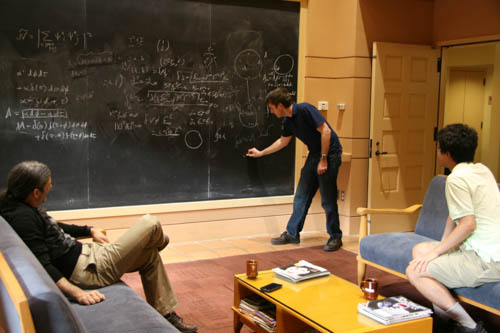 You cannot walk more than a dozen paces at the Kavli Institute for Theoretical Physics, a cloister of sorts for the more theoretically- and mathematically-inclined of the science community, without happening onto a chalkboard.
You cannot walk more than a dozen paces at the Kavli Institute for Theoretical Physics, a cloister of sorts for the more theoretically- and mathematically-inclined of the science community, without happening onto a chalkboard.
Secured on at least one wall of each small office on the building’s two floors is a spacious chalkboard. Chalkboards run across the entire length of the building’s auditorium. At the front of the building’s main lecture hall is a two-tier set of chalkboards, with a sliding mechanism for interchanging the low slabs for the high.
A gorgeous pair of chalkboards with tops too high to reach, at least for the shorter specimens in the building, flank a common room where the physicists at Kavli eagerly gather mid-afternoon almost everyday for a treat of store-bought cookies, coffee, tea, and, most importantly, conversation, often with chalk in hand, with their peers. A lovely atrium off of this common room has four sets of chalkboards the size and shape of double-doorways. Even at the intersection of two hallways on the second floor, there are two sets of chalkboards.
It is at these chalkboards where scientists—who convene at this pinch-yourself beautiful setting on the campus of the University of California in Santa Barbara, for programs with names like “The Neurophysics of Space, Time and Learning” and “New Methods in Nonperturbative Quantum Field Theory”—to tap out in chalk their latest and most tentative brainchildren.
Usually in twos, but sometimes in threes and fours, or even by themselves, they execute staccato and percussive hand motions, leaving behind tracings that for most everyone else might as well be Greek. Actually there are plenty of alphas, betas, sigmas and taus to be seen in the equations, so these scribblings are both literally and figuratively Greek. To most of us, anyway. But to the chalk users, the scribblings begin the transformation of what is the most ineffable and ethereal of all phenomena—thoughts inside of our own heads—into more concrete and shareable forms that make any meeting of minds possible at all.
What a fitting anti-symmetry that the means for this brain-to-symbol transformation, the chalk and chalkboard, derive from the most earthy of sources. The chalk is calcium carbonate, the stuff of limestone, which once was the stuff of shells and the armor of tiny creatures known as coccolithophores that over eons of living and dying, in one place, can leave behind such majestic constructions as the famous white cliffs in Dover, England.
The chalkboard these days most often is a sheet of steel with a slip of silica flour furnace-baked into a ceramic coating and then opacified with another set of powderized minerals, which gets furnace-fused into the silica base. At the chalkboard, thought morphs into transient stone, soon to be swiped away to make room for the next equation or at least so that the chalkboard will look nice and clean in the morning.
The scientists I have spoken to at Kavli say their their chalkboard sessions are ways to clarify blurry thoughts, to work out bugs in half-baked theories in collaborative on-the-fly edits replete with chalk-frosted fingers and palms, and to see, perhaps for the first time, the inklings of a great thought—perhaps one they will be most proud of in their careers—staring back at them.
Photo: Ivan Amato
__________
Ivan Amato, founder and facilitator of DC Science Cafe, has been a science communicator since the last millennium. From February through April of 2014, he is a journalist-in-residence at the Kavli institute for Theoretical Physics.
Collected on Facebook and Twitter and email, so far: other places with blackboards everywhere include Institute for Advanced Study, Princeton, International Centre for Theoretical Physics, the Perimeter Institute. It’s SUCH a good idea.
Great Post!